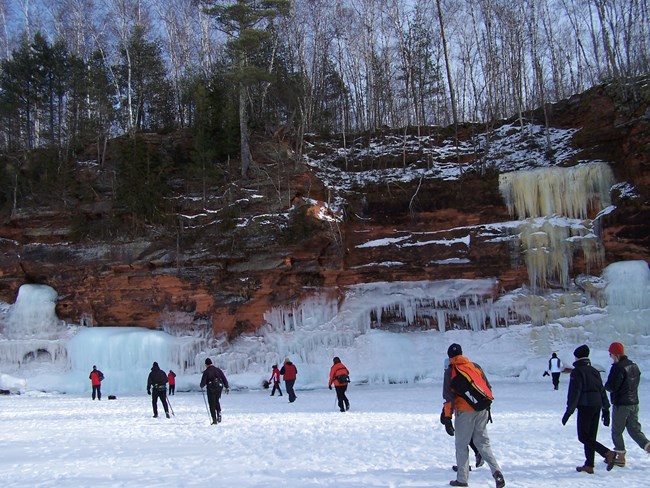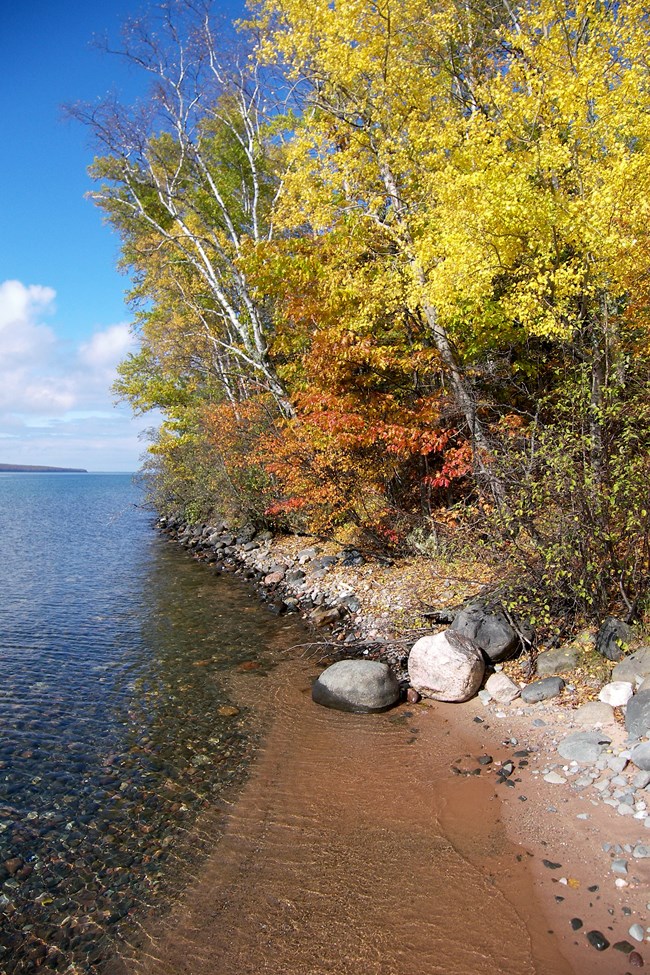
NPS Photo Decreasing Ice Cover on Lake Superior:Negative Economic, Cultural, Social and Ecologic Impacts of a Changing ClimateVisitors, potential visitors, and locals are often disappointed that the Mainland Ice Caves haven't been accessible since 2015. But global monitoring has shown that Lake Superior is the 2nd fastest warming lake on earth, and that its water temperatures are increasing at double the rate of atmospheric temperatures. Increasing air temperature reduces the amount and time of ice cover, which creates an “amplification effect” driven by reduced albedo (the fraction of light reflected from a surface). This allows energy from sunlight to be absorbed more readily by darker water that would have been (reflected) by ice and snow, resulting in an amplified increase in water temperatures. As a result of these processes the average ice cover on Lake Superior has declined by 79% from 1973 through 2010. The "ice season”, as gauged by the number of days that the Madeline Island ferry doesn’t run during winter due to freeze up, has decreased an average of 3 days per decade since 1845. In its entire 132-year history the ferry has run through the winter only 5 times, and all of those have occurred since 1998. While impacts associated with a warming lake and loss of ice present substantial negative economic effects, undesirable influences also extend into our atmosphere, soil, and water. Ice cover is essential to protect the whitefish and other fish eggs, from fall spawning, in shoals through winter. The presence of cold-water fish species, as well as boreal and temperate tree species will likely change or be lost. Habitats may change faster than some organisms can adapt, leading to migration, extinction and worsening invasive incursions. Cultural, societal, and ecologic ties to the land, animals and water that we have known will be lost. Existing impacts being seen from climate related changes in our area include:
Additional potential consequences of projected climate related changes include:
Many of these climate influenced changes have gone unnoticed for decades until they have become impossible to ignore. What changes have you noticed or heard about where you live, maybe even seen in your own backyard? What future changes might you see? Another way to think about these potential climate-induced modifications is to ask yourself how will the natural world I know be affected? How vulnerable are the landscapes and ecosystems you care about? 
NPS photo Climate Change Vulnerability AssessmentAs our climate continues to change, it is increasingly clear that natural landscapes and ecosystems are being affected in a variety of ways. Park staff have observed notable changes right here in our own backyard. We're concerned that continued change will challenge our mission to preserve and enhance the ecological and cultural legacy of this remarkable place. The National Park Service and Apostle Islands National Lakeshore has undertaken a vulnerability assessment to gather the best available information on how climate change may affect the park’s terrestrial ecosystems. This assessment, created by a team of local experts representing diverse institutions and disciplines, is designed to provide information about what ecosystems are vulnerable, how vulnerable they are, and why they are vulnerable. By improving the understanding of local vulnerabilities to climate change, we can start to draw conclusions about potential ecosystem susceptibility and change across a range of plausible future climate scenarios by the end of the 21st century. The "Climate Change Vulnerability Assessment for Terrestrial Ecosystems at Apostle Islands National Lakeshore" report, published in 2020, is the result of the collaboration of staff from Apostle Islands National Lakeshore and partner organizations to identify climate change risks to a variety of terrestrial ecosystems at the park. Spearheaded by Stephen Handler of the U.S. Forest Service and the Northern Institute of Applied Climate Science, in concert with a panel of subject matter experts, the effort sought to identify climate-associated vulnerabilities through literature reviews, ecosystem modeling, and observation. One of the main goals of the project was to generate information from the vulnerability assessment that management can integrate into on-the-ground management actions and decisions. While the vulnerability assessment is complete, future components include development of an adaptation demonstration project and other educational outreach products. Other goals include increasing visitor and staff understanding regarding impacts of climate change on parkwide terrestrial resources and ecosystems, continuing to monitor and assess how the park is responding, and sharing ways in which society and individuals can make choices to reduce climate change. What we do matters, and each person can contribute to a positive difference. Awareness is a good first step to pushing back against climate change. Additional Climate Change Resources
Climate Change Response StrategyThe National Park Service has established an overarching Climate Change Respone Strategy in response to the impacts climate change will have on all of our nation's national parks. Efforts of the NPS Climate Change Response Program are coordinated around four areas:
Apostle Islands National Lakeshore actively works to integrate all four areas into park planning, management, operations, and staff culture. Our team is dedicated to policies and practices that improve environmental performance and fosters long-term sustainability. |
Last updated: November 14, 2024
